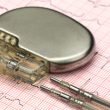Courtesy of the SBHCI. After treating the culprit lesion in patients with acute myocardial infarction complicated by cardiogenic shock, continuing revascularization of all other lesions worsens outcomes. This finding of the CULPRIT-SHOCK trial has changed entirely the way we treated this patient group and will surely modify guidelines. Culprit-lesion treatment with the option to perform...
2.0-mm DES for Very Small Vessels: Are They Viable?
The reference vessel diameter is a fundamental factor for restenosis after coronary angioplasty even with drug-eluting stents. The smallest sized stents available are 2.25 mm in diameter, but even smaller vessels can be symptomatic. This was a prospective multicenter trial of the Resolute Onyx 2.0-mm zotarolimus-eluting stent. The primary endpoint was target lesion failure. Read also: “Effects...
End of Discussion on the Impact of Pacemaker After TAVR?
Transcatheter aortic valve replacement (TAVR) is often associated with conduction abnormalities, which usually end with permanent pacemaker (PPM) implantation in 10-40% of patients. Factors predisposing to PPM after TAVR have been studied in great detail, but their short- and long-term clinical impact is still controversial. Recently, outcomes from a large cohort of patients were...
Early Coronary Angiography in High-Risk Non-ST-Elevation ACS
Coronary angiography is essential for patients admitted with non-ST-elevation acute coronary syndrome, since it allows physicians to confirm the diagnosis, stratify the risk, and define the revascularization and antithrombotic management strategies. There is no doubt that these patients should be studied invasively, but the timing for that is still uncertain. Coronary catheterization within...
Frequency and Evolution of Cardiac Perforation in Patients with a History of MRS
Courtesy of Dr. Carlos Fava. Coronary perforation (CP) is a very uncommon event (≈0.4%), associated with severe complications that entail risk of death. It has usually been related to patients with a history of myocardial revascularization surgery (MRS). However, this group usually presents lower rates of cardiac tamponade due to pericardial fibrosis caused by surgery. This...
Introducing the number one enemy of PCI: diabetes
About 25% of patients with multivessel disease undergoing myocardial revascularization surgery or PCI have diabetes. In this subgroup, the benefit of surgery in terms of mortality has long been shown: in the BARI study (Bypass Angioplasty Revascularization Investigation) patients undergoing PCI had close to double the mortality rate at 5 years compared to those...
Is Same-Day Discharge After Angioplasty Safe?
Overnight observation after coronary angioplasty has been the standard of care in the United States. The foundations for this practice go back to the early days of balloon angioplasty, when acute occlusion and access-site complications were frequent. There are several registries and randomized studies showing the clear safety of same-day discharge after coronary angioplasty. This practice...
SYNTAX II: Better Stents, IVUS, FFR, or a Combination of All of Them to Catch Up with Surgery
In patients with 3-vessel disease, surgery obtained better outcomes than angioplasty, according to results from the SYNTAX and FREEDOM trials, which used first-generation drug-eluting stents. Even in the BEST trial, which used new-generation stents, surgery still offered far better outcomes. Nobody is surprised by the fact that, whenever angioplasty evolves due to a new device...
FOURIER: Efficacy of Evolocumab for Ultra-Low LDL Levels
It seems that a LDL level of 70 mg/dL is no longer low enough for high-risk secondary patients; in consequence, this study attempted to set a new target, one that appears almost impossible to reach: 40 mg/dL or lower. This study, simultaneously presented at the European Society of Cardiology Congress 2017 and published in The Lancet, showed...
COMPASS: A New Place for Rivaroxaban in Chronic Ischemic Heart Disease
Combining low doses of rivaroxaban and aspirin seems to be the best strategy for patients with stable chronic ischemic heart disease, according to this new study presented at the European Society of Cardiology Congress 2017, which was published simultaneously in the New England Journal of Medicine. Compared with low-dose aspirin alone, the combination of aspirin...









